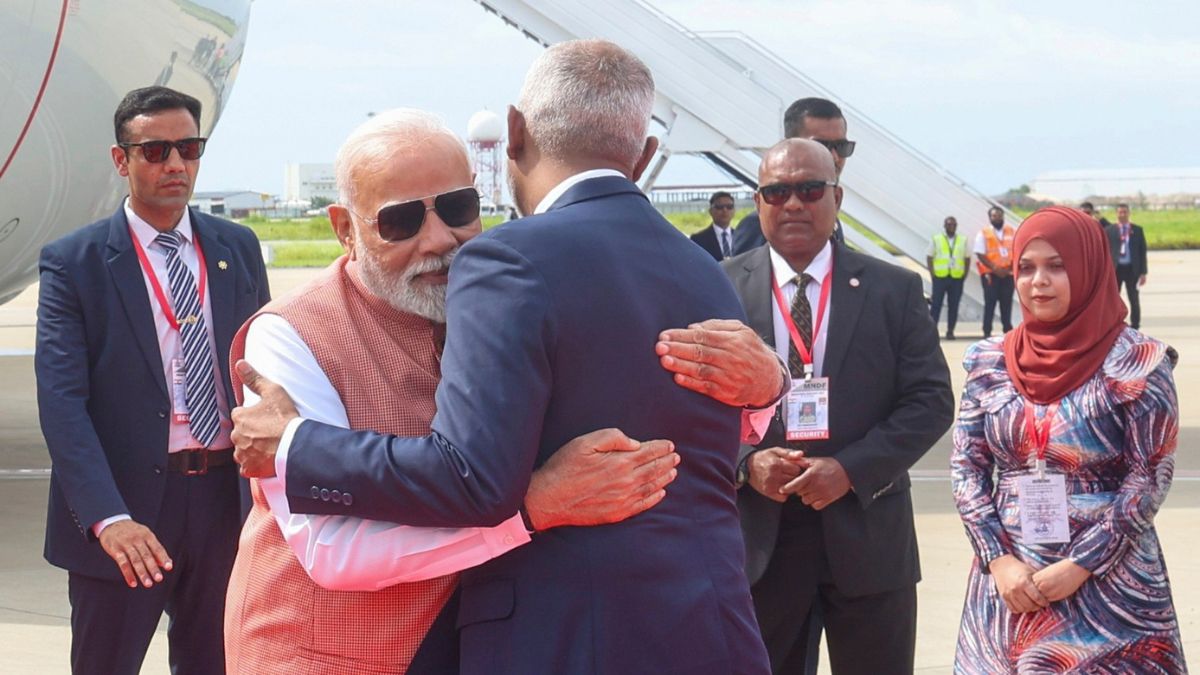From diplomacy to daily life: Why the Maldives and India remain deeply connected
 rime Minister Narendra Modi, and Maldives President Mohamed Muizzu, back to camera hug each other upon Modi's arrival at the airport, in Male | AP
rime Minister Narendra Modi, and Maldives President Mohamed Muizzu, back to camera hug each other upon Modi's arrival at the airport, in Male | AP
The slogan “India Out” echoed loudly during recent political cycles. But for many of us living in the Maldives, especially beyond the capital it felt more like rhetoric than reality. Because the truth is far more layered, more lived, and more human. The Maldives and India are not just neighbours. They are interconnected societies, economies, and cultures. And that connection continues to grow, not fade.
This year marks 60 years of formal diplomatic relations between the Maldives and India. But the relationship is older than that. It’s embedded in shared history, religious ties, trade routes, language, and family structures that predate the modern state. While leaders come and go, and politics shift, what remains constant is the people-to-people connection, a foundation strong enough to weather turbulence.
We were reminded of that during recent high-level engagements, including the visit of Maldivian President Dr Mohamed Muizzu to New Delhi, followed by Indian officials reaffirming support through major bilateral initiatives. These meetings weren’t just symbolic gestures. They were signals of intent: to reset, reinforce, and reimagine a partnership that remains vital to both nations.
India recently extended MVR 8.63 billion in credit line assistance to the Maldives, with a major focus on 4,000 housing units to be developed in Greater Malé. Housing is not a luxury issue, it’s one of the country’s most pressing challenges. For thousands of families in Hulhumalé, Malé, and Addu, these projects will mean long-awaited access to stable homes, improved quality of life, and urban decongestion.
In parallel, the launch of Free Trade Agreement (FTA) negotiations between India and the Maldives marks a major milestone in bilateral economic cooperation. This potential agreement could open up new markets for Maldivian fisheries, boost service-sector exports, and increase Indian investments in sectors like logistics, healthcare, education, and digital infrastructure. It’s a strategic step forward, especially as both countries aim to diversify their economies and embrace digital transformation.
But beyond the deals and documents, there’s a deeper story, one that plays out quietly across the islands.
As someone who has worked as a journalist across the atolls, I’ve observed something striking: almost every inhabited island has at least two or three Indian–Maldivian families. Many of them carry Overseas Citizen of India (OCI) cards, and others hold Non-Resident Maldivian status through marriage or long-term residence. My own family belongs to this group, and I say this with pride. These households don’t exist in diplomatic compounds; they are part of the community. They run shops, teach in schools, serve in hospitals, and form part of the country’s social and cultural makeup.
This isn’t just soft power. It’s lived reality. And it’s why the India–Maldives relationship isn’t sustained only through strategic documents, it endures because it exists on a human level.
India’s development footprint is equally visible across the Maldives, from health centres and training programs to coastal surveillance, renewable energy, water and sanitation systems, and disaster preparedness. Even in the most remote atolls, you’ll find signs of Indian collaboration, be it a donated ambulance or a trained technician.
Projects like the Hanimaadhoo Airport expansion or the upcoming Greater Malé Connectivity Project stand as physical symbols of this cooperation, visible, long-term, and locally impactful.
That said, it’s understandable for a small nation like the Maldives to demand transparency, accountability, and mutual respect in all foreign partnerships, including with India. Sovereignty is not negotiable. But sovereignty also includes the right to choose productive, respectful, and mutually beneficial relationships. And the India–Maldives partnership, despite challenges, remains one of the most stabilising and enduring alliances in the region.
Let us also not forget India’s timely support in moments of national crisis during the 1988 coup attempt, the 2004 tsunami, the 2014 Malé water crisis, and most recently, during the COVID-19 pandemic. These weren’t transactional moves. They were rapid, unconditional responses grounded in proximity, responsibility, and friendship.
As both countries look to the future, the focus must be on mature diplomacy rooted in regional stability, sustainable development, and respect for each other’s choices. Strategic competition in the Indian Ocean is a reality. But so is the fact that India and the Maldives are bound by geography, history, and shared interests, and those cannot be erased by slogans.
“India Out” may have made headlines. But in the daily lives of ordinary Maldivians and Indians through development aid, trade, education, medical care, or family, India was never out. It has always been in. And for many across these islands, it always will be.
Nazeem Noushad is a Malé-based journalist and media entrepreneur with deep roots in both India and the Maldives.
World